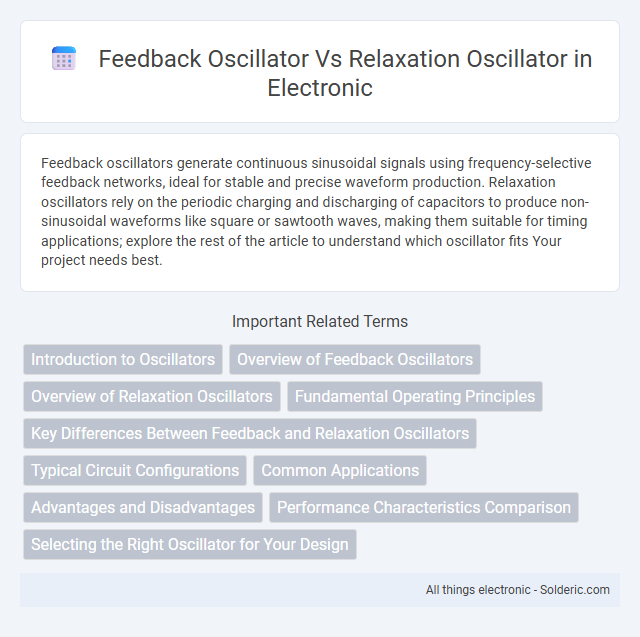Feedback oscillators generate continuous sinusoidal signals using frequency-selective feedback networks, ideal for stable and precise waveform production. Relaxation oscillators rely on the periodic charging and discharging of capacitors to produce non-sinusoidal waveforms like square or sawtooth waves, making them suitable for timing applications; explore the rest of the article to understand which oscillator fits Your project needs best.
Comparison Table
| Feature | Feedback Oscillator | Relaxation Oscillator |
|---|---|---|
| Oscillation Principle | Uses positive feedback and frequency-selective networks | Relies on charging and discharging of reactive components |
| Waveform Output | Produces sinusoidal waveforms | Generates non-sinusoidal waveforms like square or sawtooth |
| Frequency Stability | High frequency stability and accuracy | Lower frequency stability |
| Common Components | Resistors, capacitors, inductors, and amplifiers | Capacitors, resistors, and active switching devices |
| Applications | Radio transmitters, signal generators, communication circuits | Timing circuits, flashing lights, tone generators |
| Complexity | More complex design due to feedback and tuning | Simple and easy to design |
| Frequency Range | High-frequency range (up to GHz levels) | Low-frequency range |
Introduction to Oscillators
Oscillators generate continuous waveforms critical for timing and signal processing in electronic circuits. Feedback oscillators use positive feedback loops to produce sinusoidal waveforms with stable frequency, making them ideal for radio and communication systems. Relaxation oscillators rely on charging and discharging capacitors to create non-sinusoidal waveforms, useful for generating pulses or timing signals in your electronic applications.
Overview of Feedback Oscillators
Feedback oscillators use positive feedback to sustain continuous sinusoidal oscillations by reinforcing the signal at a specific frequency determined by the resonant circuit. Common types include the Hartley, Colpitts, and Pierce oscillators, each relying on LC or crystal components to maintain frequency stability and low distortion. Your choice of a feedback oscillator is ideal for applications requiring precise, stable, and pure sine wave generation in radio frequency and communication systems.
Overview of Relaxation Oscillators
Relaxation oscillators generate non-sinusoidal waveforms such as square, triangular, or sawtooth waves by periodically charging and discharging a capacitor through a nonlinear element. These oscillators are widely used in timing circuits, pulse generation, and waveform shaping due to their simplicity and ease of implementation. Your choice of a relaxation oscillator is ideal for applications requiring stable switching frequencies and sharp transitions rather than smooth sinusoidal signals.
Fundamental Operating Principles
Feedback oscillators generate continuous wave signals by amplifying and phase-shifting a portion of the output back to the input, achieving sustained oscillations through positive feedback loops. Relaxation oscillators rely on the periodic charging and discharging of energy storage elements, such as capacitors, to produce non-sinusoidal waveforms like square or sawtooth waves. The fundamental distinction lies in feedback oscillators maintaining steady-state oscillations via linear components and phase criteria, while relaxation oscillators use nonlinear switching actions to create oscillation cycles.
Key Differences Between Feedback and Relaxation Oscillators
Feedback oscillators generate continuous sine waves using positive feedback and frequency-selective networks, producing stable and low-distortion signals ideal for communication systems. Relaxation oscillators rely on the charging and discharging of capacitors through nonlinear devices, producing non-sinusoidal waveforms like square or sawtooth waves used in timing and waveform generation applications. Understanding these distinctions helps you select the appropriate oscillator type based on signal purity, waveform shape, and application requirements.
Typical Circuit Configurations
Feedback oscillators, such as the Colpitts and Hartley designs, typically use LC tank circuits with inductors and capacitors to determine frequency, relying on continuous feedback for stable sinusoidal output. Relaxation oscillators, like the Schmitt trigger or multivibrator circuits, employ resistors, capacitors, and active devices to produce non-sinusoidal waveforms through charging and discharging cycles. Understanding these typical circuit configurations helps you select the right oscillator type based on frequency stability and waveform requirements.
Common Applications
Feedback oscillators are widely used in communication systems for generating stable sinusoidal signals in radio transmitters, signal generators, and clock circuits. Relaxation oscillators find common applications in timing circuits, flashers, and pulse generation where non-sinusoidal waveforms like square or sawtooth waves are required. Both oscillator types are essential in electronics, with feedback oscillators favored for frequency stability and relaxation oscillators preferred for simplicity and waveform variety.
Advantages and Disadvantages
Feedback oscillators offer precise frequency stability and low distortion, making them ideal for high-frequency applications such as RF signal generation. They require complex circuitry and are sensitive to component variations, which can increase design complexity and cost. Relaxation oscillators provide simplicity and ease of integration with digital circuits but suffer from poor frequency stability and higher harmonic distortion, limiting their use in precision applications.
Performance Characteristics Comparison
Feedback oscillators provide continuous sinusoidal output with high frequency stability and low phase noise, making them ideal for RF and communication applications. Relaxation oscillators generate non-sinusoidal waveforms such as square or triangular waves, characterized by lower frequency stability and higher harmonic distortion but offer simplicity and ease of implementation in timing circuits. The performance comparison reveals that feedback oscillators excel in precision and spectral purity, while relaxation oscillators are preferable for applications where waveform shape and rapid startup are more critical than frequency accuracy.
Selecting the Right Oscillator for Your Design
Feedback oscillators offer stable, sinusoidal waveforms ideal for high-frequency applications such as RF circuits, while relaxation oscillators generate non-sinusoidal waveforms suitable for low-frequency timing and pulse generation. Selecting the right oscillator depends on design requirements like frequency stability, waveform shape, power consumption, and complexity. For precision signal generation, feedback oscillators excel, whereas relaxation oscillators are preferred for simple clock and timing circuits due to their ease of implementation.
feedback oscillator vs relaxation oscillator Infographic

 solderic.com
solderic.com